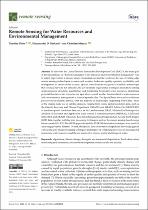| dc.identifier.citation | Dube, T., Shekede, M. D., & Massari, C. (2022). Remote Sensing for Water Resources and Environmental Management. Remote Sensing, 15(1), 18. https://doi.org/10.3390/rs15010018 | en_US |
| dc.description.abstract | In line with the United Nations Sustainable Development Goal (SDG) 6, the main goal
of the Special Issue on “Remote sensing for water resources and environmental management” was
to solicit papers from a diverse range of scientists around the world on the use of cutting-edge
remote sensing technologies to assess and monitor freshwater quality, quantity, availability, and
management to ensure water security. Special consideration was given to scientific manuscripts
that covered, but were not limited to, the development of geospatial techniques and remote sensing
applications for detecting, quantifying, and monitoring freshwater water resources, identifying
potential threats to water resources and agriculture, as well as other themes related to water resources
and environmental management at various spatial scales. The Special Issue attracted over thirteen
peer-reviewed scientific articles, with the majority of manuscripts originating from China. Most
of the studies made use of satellite datasets, ranging from coarse spatial resolution data, such as
the Gravity Recovery and Climate Experiment (GRACE) and GRACE Follow-On (GRACE-FO),
to medium spatial resolution data, such as the Landsat series, ERA5, Modern-Era Retrospective
Analysis for Research and Application Land version 2 reanalysis product (MERRA2), CLSM and
NOAH ET, and MODIS (Moderate Resolution Imaging Spectroradiometer). Google Earth Engine
(GEE) data, together with big data processing techniques, such as the remote sensing-based energy
balance model (ALEXI/DisALEXI approach) and the STARFM data fusion technique, were used for
analyzing geospatial datasets. Overall, this Special Issue demonstrated significant knowledge gaps in
various big data image processing techniques and improved computing processes in assessing and
monitoring water resources and the environment at various spatial and temporal scales. | en_US |

